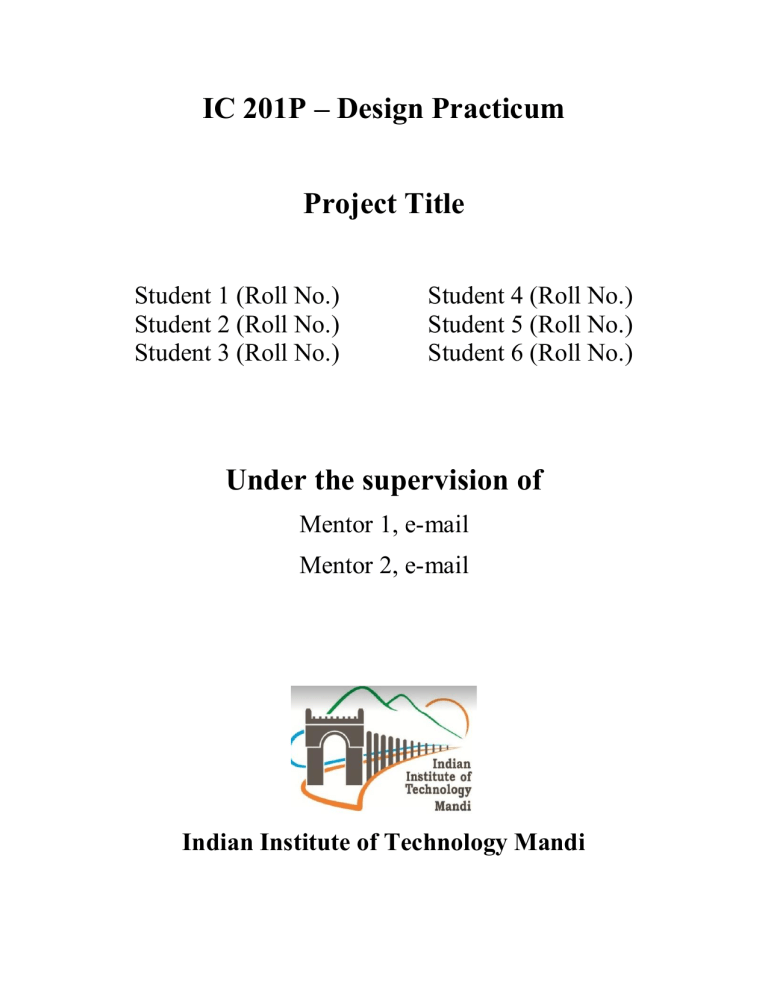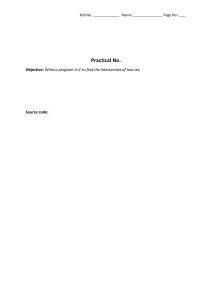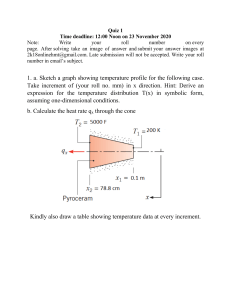
IC 201P – Design Practicum Project Title Student 1 (Roll No.) Student 2 (Roll No.) Student 3 (Roll No.) Student 4 (Roll No.) Student 5 (Roll No.) Student 6 (Roll No.) Under the supervision of Mentor 1, e-mail Mentor 2, e-mail Indian Institute of Technology Mandi Certificate This is to certify that the work contained in the project report entitled “Title of the project”, submitted by Group XX (Group no.) to the Indian Institute of Technology Mandi, for the course IC 201P – Design Practicum, is a record of bonafide research works carried out by him under our direct supervision and guidance. Mentor 1 Name Mentor 2 Name Signature and Date Signature and Date i Acknowledgements Kindly acknowledge the names of all the people who have helped you in the project. ii Abstract The overall goal of the project must be mentioned here in the abstract. (200 words) iii Contents Insert the Table of Contents here. iv List of Figures Insert the list of figures here. v List of Tables Insert the list of tables here. vi Abbreviations Insert all the abbreviations used in the report. vii Chapter 1 Introduction Discuss the following points in the introduction 1. 2. 3. 4. 5. 6. Background of the problem Scope of the problem Design philosophy used in this report Problem statement Beneficiaries (Intended market) Organization of this report 1 Chapter 2 Market Research 1. In this chapter, discuss the existing products in their market. 2. Present a comparison with the existing products/similar technologies that exist in the market. 3. Identify what are the problems associated with the existing alternatives. 4. Mention how your intended product stands different from the existing product. 5. Any other state-of-the-art must also be discussed in this chapter. 2 Chapter 3 Conceptual Design 1. In this chapter, you should discuss what was the first problem statement you formulated and how you narrowed that down to the current problem statement. 2. Brainstorming and Idea generation – Discuss about the different brainstorming sessions you had that helped you to identify all the different means of solving the problem. You can use ‘mind maps’ for this purpose. A sample mind map is shown below: Figure 1: A sample mind map. Image courtesy: https://destech.wordpress.com/ 3. Selection of the most viable ideas proposed. 4. You should discuss a decision matrix here. On what basis you have selected the present idea and rejected all the other ideas. The ‘Proposed solution’ to the problem must be presented at the end. 3 Chapter 4 Embodiment and Detailed Design 1. Product architecture - An overall block diagram highlighting the functionality of the product must be presented here. The working principle and the feasibility of the design concept must also be discussed. Figure 2: Example of product architecture (image source: google images) 2. System-level design - How each subcomponent or modules interact with each other in a product level and the function of each subcomponent. 3. Design configuration - Shape and general dimensions or sizes are established to the components that are defined in product architecture. It is largely depended on the three-dimensional constraints that define the envelope in which the product operates and the product architecture. This would be a preliminary selection of material, manufacturing process, modelling, sizing of parts etc. 4. Detailed design – This must include the following: • Electrical/Electronics aspect: Derivation of the required specification • Software part: Algorithm and its analysis 4 • Mechanical Aspects: Solid works model. Orthographic views and 3D view. 5. Results and Discussion 5 Chapter 5 Fabrication and Assembly The fabrication plan shall be discussed in this chapter. Following points must be included. 1. Bill of Materials (BOM). 2. The drawings must be presented in this section. Material description, dimension and tolerances must be added to all the part drawings. The electrical/electronics and the mechanical components should be discussed separately. 3. Manufacturing Process description: Discuss how you plan to fabricate individual parts (identify the suitable manufacturing process and the sequence of steps necessary for the fabrication). 4. Assembly 5. Limitations and Challenges: Both from the product perspective and from the fabrication perspective. 6. Scheduling plan: With the help of a Gantt chart, present a scheduling plan, for completing the tasks in minimum duration possible. 7. Contribution: The contribution of each team member must be listed here. 8. Conclusions: Overall conclusions of the project work 6 References The IEEE referencing style must be used. Kindly go through the link below for the details on the IEEE referencing style. https://ieeedataport.org/sites/default/files/analysis/27/IEEE%20Citation%20Guidelines.pdf 7


